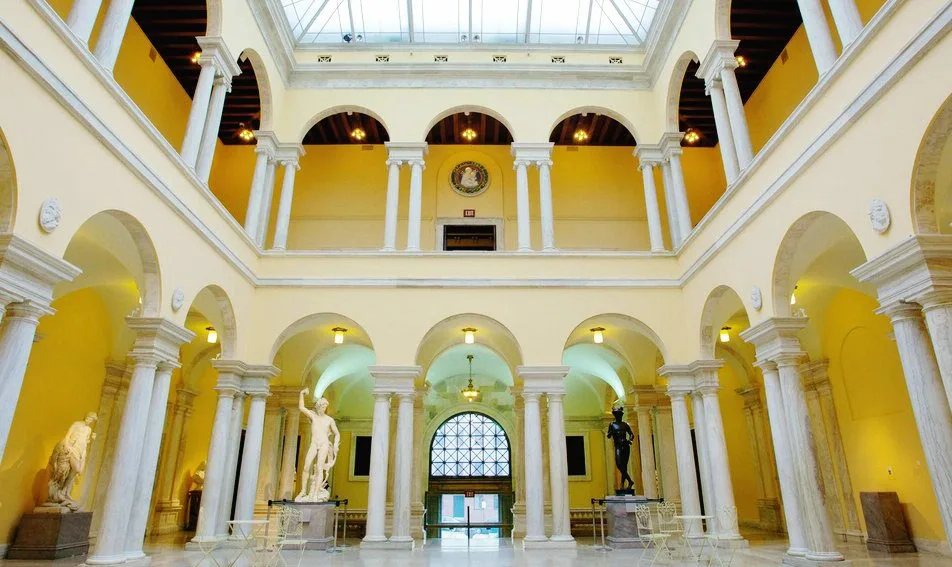Baltimore: Museology
The city of Baltimore has a rich and diverse cultural history. I explored some of the city's many museums with my family and friends in the summer of 2017. This brief post provides a commentary on those we were able to visit, including details on their collections and themes. While the city hosts more museums than we were able to visit, the following are the few upon which I can pronounce judgement--and I truly have fond memories of them all.
First Place in the list goes to The Walters Art Museum
The Iris above--a beautiful jeweled corsage exhibited at the Chicago World's Fair of 1893 and the Paris Exposition of 1900 if I'm not mistaken, along with much of Tiffany and Co.'s other art--characterizes Walters collection: unique, eclectic, and supremely beautiful.
The Walters, a wealthy family who made their fortune in brewing, collected great art over their lives, eventually leaving their collections as a bequest for public display. The varied and global nature of the pieces betray this provenance, as the impressive artwork is attention-grabbing, exhibitionist, personal and displayed in the glory and elegance of the Gilded Age. Though the iris and the many Tiffany Pieces (prolific designer Louis Comfort Tiffany crafted works of art from windows, to lampshades, to jewelry and died in 1933 at the age of 85) were memorable, I also recall the painting The Christian Martyr's Last Prayer by Jean-Leon Gerome (c. 1880) among a truly excellent oil-painting collection.
The Christian Martyrs' Last Prayer, Jean-Leon St. Gerome 1863-1883
The Walter's Museum most fascinating room however, is its "cabinet of curiosities" --a dark paneled room reminiscent of the Dutch collector's style. As the first European collectors created home museums of exotic shells, animals, and artifacts brought back from 17th century colonial and mercantile expeditions, the Walter's family created its own collection of curiosities throughout the 19th and 20th centuries.
The Museum is free to all and located at 600 N Charles St.
Second Place on the list goes to the unconventional Waterfront Museum of Battleships
I loved climbing aboard and through the battleships in the Baltimore harbor, especially the Torsk (a Tench Class submarine which torpedoed the last Japanese vessel sunk by the US Navy during WWII) and the USS Constellation (a sloop-of-war harkening to 1797 which played a crucial role in stopping illegal slave-traders in the Atlantic following America's abolition of the slave trade (importation) in 1808).
You can also climb aboard a Coast Guard Cutter and the Lightship Chesapeake for an experience that feeds the historical imagination.
The Historic Ships of Baltimore are closed Tuesdays and Wednesdays and the pass to see all ships is $18 for adults and $7 for kids ($15 for students under 21).
Third Place goes to the unforgettable Visionary Art Museum
The Visionary Art Museum is a one-of-a-kind attraction. It's exhibits are whacky and thought-provoking, outrageous and fun.
I particularly remember an exhibit featuring lunchboxes, another of an Icarus descending from the Museum ceiling, and a third of miniature furniture so detailed it enthralled. The beauty of this Museum comes from the artists' usage of different media. Metalwork, glass shards, food, plastic, trash, textiles, rubber, graffiti, stuffed animals...it's all here.
Icarus by Andrew Logan, Visionary Art Museum
A particularly great place for kids, the Museum also had a more serious rotating exhibit on recognizing black artists when I visited. Its collection might seem weird, but it teaches a lot: lessons from recycling to science, from equality to mythology can all be found within its walls.
The Museum costs roughly $16 for adults and $10 for kids/students and is located at 800 Key Highway.
Lastly I wish to recommend the Edgar Allen Poe Museum/Gravesite
Edgar Allen Poe, the poet, detective writer, and macabre author famously died, drunk and disturbed in a Baltimore gutter in 1849. Poe lived in Baltimore with his aunt and cousins for a short period in 1833-1835 and their home is open to visitors (203 N Amity St.) for a modest price.
I was unable to visit (drats, it closes at 4 pm) but I did stop by Poe's memorial gravesite at the Westminster Presbyterian Churchyard (at the corner of Fayette and Green Sts). While not a full tour by any means, this memorial was powerful to see for a historian and literary fan, as it is Poe's death, not his life, which is tied to Baltimore (to learn about his life, best visit the Richmond, VA Museum).
I've always loved Poe, especially his famous poems The Raven and Annabel Lee and his stories The Goldbug and The Murder in the Rue Morgue. The gravesite is an homage to the mysterious man and his morbid tales, set at the mortal site of his own mysterious and morbid death. Historians have long speculated foul-play and debauchery were behind his unseemly demise in this city.










Comments
Post a Comment